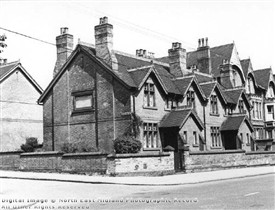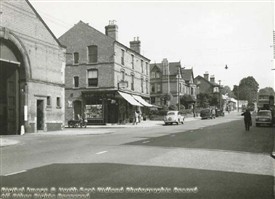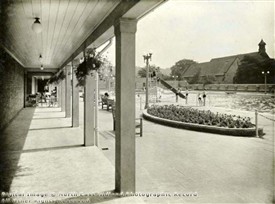Sherwood and Carrington

Cullen's Almshouses Mansfield Road Nottingham
www.picturethepast.org.uk

Mansfield Road Sherwood Nottingham showing part of the tram shed
www.picturethepast.org.uk

Carrington Lido c.1937
www.picturethepast.org.uk
A brief history of the area
The Nottingham City suburb of Sherwood covers an area within the triangle formed by Hucknall Road, Mansfield Road and Valley Road, including the Edwards Lane Estate and the area to the east of Mansfield Road from Woodthorpe Grange Park in the north to Private Road in the south. Carrington is situated to the west of Hucknall Road.
Sherwood
Sherwood is built on land that was originally the southern tip of the ancient Sherwood Forest. Until the 19th Century it was open common land used by the people of Nottingham for grazing animals. People considered it difficult and even dangerous to cross the open space of Nottingham Lings (the area now known as The Forest) because of the rough, unmade roads bordered by dense vegetation which made it ‘a lurking place for all sorts of undesirable folk’. [Source:Links with old Nottingham. Historical notes by J. Holland Walker, (1928)].
Following the 1792 Enclosure Acts, the land was gradually settled and inhabited on a permanent basis. At the same time, allotment gardens were established, enabling people to grow food for the increasing population of the city of Nottingham.
In 1814, Sherwood was a settlement of just a few dwellings; however by 1841 it had developed into a sizeable hamlet. According to the 1841 Census local inhabitants were working as lace makers, framework knitters, servants and agricultural labourers.
From the mid 1800s, parcels of land were sold off for building development and many of the allotments were lost, though some, such as BagthorpeGardens, remain in existence today.The area developed rapidly during the period after 1860, and included factories, engineering works and housing for the professional classes and better off working class people who bwanted to move out of the overcrowded city.
Some significant buildings in Sherwood include:
- The Nottingham Electric Tram shed.
Opened in 1901 on Mansfield Road, it was used as a bus garage in later years. - Woodthorpe House.
The oldest building in the area. A map of 1774 shows a dwelling on the same site. Over the years the house had connections with many prominent Nottingham families including Sir William Hugh Tomasson (1858-1922), at one time Nottinghamshire’s Chief Constable, who moved there in 1898. The house was lived in by the Tomasson family until the 1930s. During the Second World War the house was requisitioned by the War Office. After the War, the Sherwood Community Association gained use of the house and eventually it became the Sherwood Community Centre. - Nottingham City Hospital.
Originally the site of the Bagthorpe IsolationHospital (opened in 1892), and the Bagthorpe Workhouse and Infirmary (opened in 1903). The Workhouse closed in 1909. During World War 1, the Infirmary became the Bagthorpe MilitaryHospital. In 1935, by now called the City Infirmary, it became a municipal general hospital and was renamed the Nottingham City Hospital. During World War 2 the hospital treated military wounded and prisoners of war. It was awarded teaching hospital status in 1970. - Nottingham Prison.
This opened as Bagthorpe Prison in 1891 at a cost of £20,000 and designed to accommodate 200 male prisoners. In 1894 a new block opened to accommodate 40 female prisoners. The first execution was carried out in 1897. In 1930, the prison closed and was reopened as a Borstal institution in 1932. In 1950 it reverted back to being a prison, but this time as a maximum security prison. New blocks opened in 1996 to accommodate 100 more inmates. There was further rebuilding and refurbishment during 2009-10.
Carrington
The six acres of land that is now the area known as Carrington was sold off for development in the early 1800s. Some time later it was bought by Ichabod Wright, the Nottingham banker, who named it Carrington after Lord Carrington of Carrington, near Ashby Folville in Leicestershire.
A village was built on the land in 1825 and the area was soon transformed by the lace industry. In 1832, there were 34 bobbin net makers, but in just four years the number had risen to 143.
Carrington is notable for:
- Shipstone’s Brewery. In 1835, the New Inn was opened on New Street, by Thomas Beasley, a farmer. This became firstly the Carrington Brewery, then Shipstone & Co., after James Shipstone bought the brewery in 1898.
- The Gladstone Hotel , Loscoe Street, Carrington was built in 1882, one famous landlord was George Fryer, an English amateur heavyweight boxing champion, billed as ‘The Nottingham Slasher’ when fighting in the USA.
- Carrington Lido. The outdoor Lido off Mansfield Road (Next to St John’s Church) was opened on 29th July 1937 at a cost of £20,000. It closed in 1988. The site is now a children’s recreation ground.
- The Great Central Railway. From 1895 the Great Central Railway crossed through the area, most of it via an underground tunnel on its way to and from Victoria Station, Nottingham. Carrington Station opened in 1899 and closed in 1929.
- Cullen’s Almshouses. Cullen’s Almshouses on Bingham Road, Carrington were designed by the Nottingham architect William Fothergill in 1882. They were paid for by the Misses Elizabeth Marianne Cullen, in memory of their brother James Cullen, who died in 1878.
The Carrington Tenants and Residents Association published a leaflet providing a guided walk to historic sites in the area. See copy below.
This page was added by
H W on 01/05/2013.